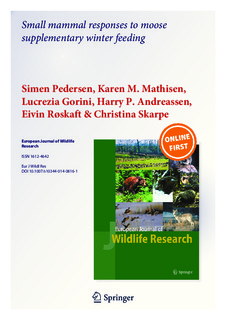Small mammal responses to moose supplementary winter feeding
Pedersen, Simen; Mathisen, Karen Marie; Gorini, Lucrezia; Andreassen, Harry Peter; Røskaft, Eivin; Skarpe, Christina
Journal article, Peer reviewed
Permanent lenke
http://hdl.handle.net/11250/194143Utgivelsesdato
2014Metadata
Vis full innførselSamlinger
Originalversjon
10.1007/s10344-014-0816-1Sammendrag
Supplementary feeding of wild large herbivores is a
widespread practice in North America and Europe. The presence
of feeding stations may have ecological consequences
through changes to animal distributions, patterns of herbivory
and a net nutrient input into the ecosystem. In Fennoscandia,
supplementary feeding of moose in winter (Alces alces) is
increasing. Although it has been shown to affect bird communities,
its effects on small mammal communities were unknown.
Here, we studied the effects of moose supplementary
feeding stations on plants and on abundance, reproduction,
and biomass of small mammals in years with low and high
vole abundance. We sampled small mammals with snap traps
and conducted surveys of the field layer vegetation, at varying
distances from moose supplemental feeding stations. Due to
the vegetation changes induced by feeding stations, abundance
of common shrews (Sorex araneus) and Microtus voles
were positively affected by long-term moose winter feeding,
while bank voles (Myodes glareolus) were not affected.
Moose feeding stations did not affect reproduction, individual
body mass, or the total biomass of small mammals. Moose
winter-feeding stations have impacts on nontarget species, providing islands of preferred grass and forb habitat for
Microtus spp. and common shrews, allowing them to penetrate
into a matrix of less preferred forest habitat.
Beskrivelse
This is an open access article. You can find it by following this link: http://link.springer.com/article/10.1007/s10344-014-0816-1
